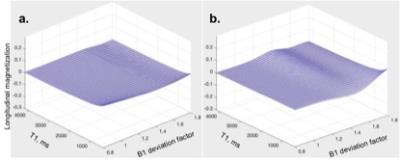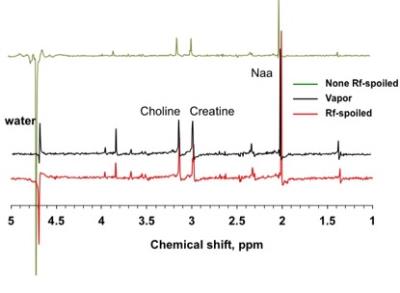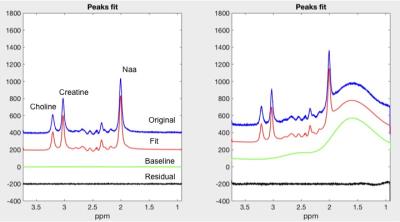5504
Simultaneous water and lipid suppression for brain 1H MR spectroscopy at 7T using multiple RF pulses with spoiling phases1National Institute of Mental Health, National Institute of Health, Bethesda, MD, United States
Synopsis
The variation of RF phases may effectively suppress water and lipid coherent signals, as similar effect has been previously demonstrated in GRE MR imaging sequences. We demonstrate a new suppression sequence capable of simultaneous water and lipid suppression with short inter-pulse delay and RF phase spoiling. Monte Carlo analysis showed that the proposed technique can significantly improve both accuracy and precision of metabolite quantification by suppressing lipid contamination.
Introduction:
Water and lipid signal suppression is important for obtaining high quality proton MR spectra at 7T. While many techniques have been developed for water suppression there are few options for suppressing the scalp lipids or lipids found in brain tumor. Conventional outer volume suppression schemes may potentially interfere with metabolite signals, especially when voxels of interest are in close proximity to the scalp lipids. In this abstract we describe a new suppression sequence capable of simultaneous water and lipid suppression. We designed a multi-RF-pulse sequence with short inter-pulse delay and RF phase spoiling. The variation of RF phases contributes to cancellation of coherent signals in a fashion bearing certain similarity to RF spoiling in GRE imaging. The short inter-pulse delay allows our sequence to perform simultaneous suppression of water and lipid with interleaved excitation pulses. Monte Carlo simulation is employed to estimate the improvement by the new dual suppression sequence for metabolite quantification in the presence of lipid interference.Method:
All scans were acquired using a 32-channel head coil on a 7T Siemens scanner. A standard MRS water phantom was used for sequence testing. Written informed consent was obtained from 6 healthy volunteers (3 males and 3 females, 24 to 35 years old). The proposed RF-spoiled dual suppression sequence consists of 18 RF pulses. Water and lipid excitation RF pulses were positioned alternatively to generate dual band suppression. All pulse segments were set to 9 ms duration with 25 ms interpulse delay time between water-suppressing pulses. Spoiled gradients were applied after every two pulse segments (water and lipids). The RF flip angle (water)/RF flip angle (lipids)/RF phase were 70°/70°/234°, 70°/70°/585°, 125.8°/125.8°/1053°, 70°/70°/1638°, 125.8°/125.8°/2340°, 70°/70°/3159°, 125.8°/125.8°/4095°, 125.8°/125.8°/5148°, and 125.8°/125.8°/6318°. Frequency offsets for water and fat pulses were set at 0 and -4.0 ppm, respectively. The PRESS sequences used isotropic voxel (2 x 2 x 2 cm3), a repetition time (TR) of 2.5 s with TE1 = 69 ms and TE2 = 37 ms. 2048 data points were acquired. Phantom and in-vivo data were acquired with 2 and 32 averages, respectively. Monte Carlo simulations were implemented to examine the fitting results with and without the presence of large baseline due to contamination by lipid signals. Simulated datasets were generated using metabolite concentrations and baselines from fitting the in-vivo datasets. Monte Carlo simulations were repeated 100 times with the same noise level but different realizations of random noise on two simulated datasets, one with in-vivo baseline and the other with flat baseline.Results and Discussion:
It was well known, especially for long T2 signals, when inter-pulse delay is short, even with gradient spoiling, transverse signals may not be fully spoiled. Application of variable phases to spoiling pulses may further suppress the residual signal. Bloch simulations based on the parameters of VAPOR[1] and the proposed short-interval multi-pulse sequences with and without phase spoiling, were implemented to demonstrate the effects of water signal suppression (see Figs 1 and 2). The simulation results suggest that the two techniques are comparable in terms of water suppression. Phantom experiments using the three multi-pulse sequences were shown in Fig. 3 for residual water signal comparison. The in-vivo scans using VAPOR and our RF-spoiled sequence were shown in Fig.4. Given that the voxel location is very close to the scalp lipid (Fig. 4), the spectrum using VAPOR is severely contaminated by the lipid signal. In comparison, with our RF-spoiled dual suppression sequence, simultaneous suppression of water and lipid was achieved. Monte Carlo simulations were performed to analyze in-vivo fitting results. As shown by Fig. 5, the proposed technique, which suppresses lipids and flattens the baseline, significantly improved both accuracy and precision of metabolite quantification.Conclusion:
With RF spoiling simultaneous water and lipid suppression can be achieved without practically compromising B1 and T1 insensitivity of the suppression effects. Monte Carlo simulation showed that the proposed technique can significantly improve accuracy and precision of metabolite determination in the presence of lipid signal.Acknowledgements
This work was supported by the intramural research program of National Institute of Mental Health.References
1. Tkac I, Andersen P, Adriany G, Merkle H, Ugurbil K, Gruetter R. In vivo H-1 NMR spectroscopy of the human brain at 7 T. Magnetic Resonance in Medicine 2001;46(3):451-456.
2. Zur, Y., M. L. Wood, and L. J. Neuringer. "Spoiling of transverse magnetization in steady-state sequences." Magnetic resonance in medicine 21.2 (1991): 251-263.
Figures




